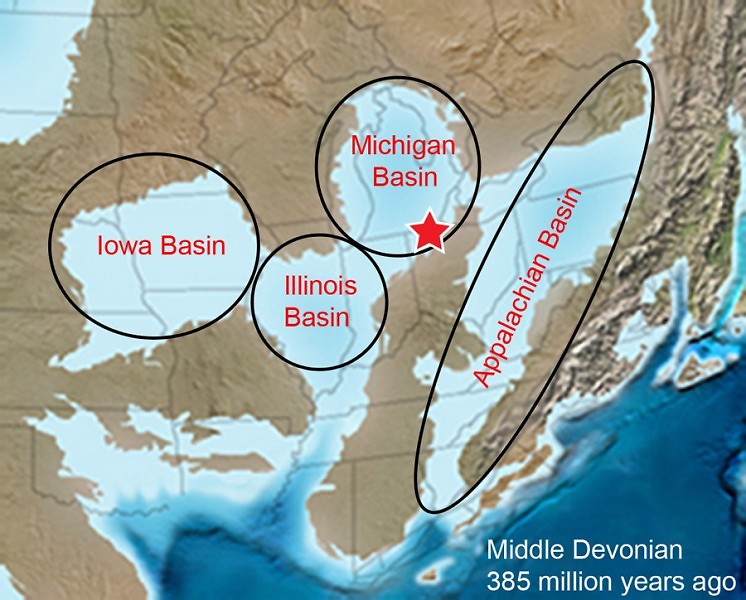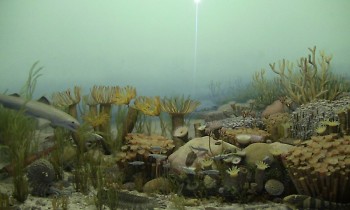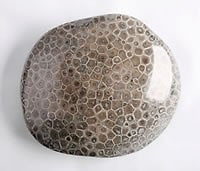Today the City of Grand Rapids is a modern city with large buildings, suburban sprawl, and statues dedicated to males of European ancestry. Though these elements are part of our history as a city, they fail to tell the full story of the land that the city now sits on, or the inhabitants who once lived here. People of non-native descent came into the area slightly less than 200 years ago. Paleontology studies have shown that the landscape has changed drastically over 500 million years.
Fossil remains, geology show Michigan's early history
The land that is Michigan holds its most ancient history within its geological record. Billions of years of lava flows, increased tectonic movement, the ebb and flow of seas, and erosion created the land we know now as Michigan.
The first advanced inhabitants of this land came during the Paleozoic Era which was the first of the Phanerozoic Eon. The contours of the state that give it a mitten appearance would not exist for another few hundred million years, during the Cambrian Period. Much of North America including most of Michigan was covered in water during the start of this era and located along the equator.
Trilobites, a form of early crustaceans, dominated the sea floors which also had small cephalopods roaming in it. Fossil remains of these creatures have been found in northern Michigan. 50 million years later during the Ordovician period these cephalopods would evolve into a large cone-shaped creature resembling a squid that took a seat at the top of the food chain.
It is presumed that although the seas were thriving with primitive creatures and vegetation, the parts of the state that made up dry land were devoid of anything living. This period saw two great ocean invasions that covered and eventually retreated over 50 percent of North America in water.
Ancient seas form Petoskey Stones, Grand River rapids
After about 60 million years, warm, shallow seas came down again from the Arctic and covered Michigan during the Silurian period. At this time the land would have been in a subtropical climate that gave rise to large coral reefs across the state. Fossil findings show that the largest and oldest reef extends through the center of the Upper Peninsula. A species of coral that lived during this time period would eventually become fossilized and become what we refer to as Petoskey Stones.
The seas retreated over time, leaving a desert scattered with fossilized remains that eventually formed the limestone that is located over one hundred and twenty feet below us today. The sections of this exposed limestone is what created the City’s famous rapids. Much of the salt deposits that were left from retreating seas of this period are still mined in Detroit.
The Devonian period around 400 million years ago saw the rise of vertebrates in Michigan. North America was covered with up to 40 percent of water. There were a great number of fish swarming the salt and fresh water seas. The Ganoid species were in a crude state of evolution. Many of them had armor plating with two of their relatives, the Gar Pike and the Sturgeon, still existing in Great Lakes today. Primitive plants, such as the seed fern, developed from marine algae. On land the Tiktaalik, the link between finned fish and early amphibians, started to use its muscular fins to drag itself around land.
Muskegon’s oil, Grand Rapids’ gysum mines made
Billions of creatures swam the shifting seas sinking to the ocean floor when they died, eventually becoming covered with mud. Over a long period of time mud, plant matter, rocks, soil and additional remains of creatures continued to cover the remnants. This continued build up created pressure and heat turning them into oil and natural gas. The gas moved closer to the surface and the oil sunk deeper. The layers of soil eventually became the shale, sandstone, and limestone sealing the energy rich substances into a rocky tomb that would be opened by man four hundred million years later. Dixie Oil Company, owned by Standard Oil, was operating in Muskegon county when they found some of it in 1927.
The Carboniferous Period, 350 million years ago ushered in a time of insects and ferns on the land. The beginning of this time is broken down into a subperiod known as the Mississippian. The seas came and went altering the landscape and leaving deposits every time they did. This allowed for distinct layers to form below the surface that read like pages along a geological time scale. The Mississippian seas of this time period occasionally covered our area, leaving lagoons. These lagoons high in calcium and sulfate would evaporate leaving deposits, creating the gypsum that once was a major part of the Grand Rapids economy.
Prehistoric jungles become coal basin under Kent County
At the end of the Carboniferous Period, known as the Pennsylvanian subperiod, Michigan was a semi-tropical jungle featuring primitive vegetation. Ferns without bark, some of which bloomed scentless unattractive flowers, grew to almost 100 feet. Millions of generations of trees grew and died in the jungle. The trees that fell in the swampy parts of the jungle were covered up by water and soil that became rock over time. The forces of time and pressure on these trees would eventually see this prehistoric jungle become the coal basin that sits underneath a large area of the U.S. including the upper northeast part of Kent county.
In the sky above one foot long dragon flies swarmed in droves on the ground and cockroaches the size of a man’s palm crawled around. Reptiles started to appear, evolving from amphibians, not dependent on water to lay their amniotic eggs. Towards the end of this period the rain forests gave way to deserts which decreased the amphibian populations and caused an evolutionary shift in reptiles.
300 million year mystery in Michigan
The next 300 million years is a mystery in Michigan. The strata layers of the Permian Period through all three periods of the Mesozoic era are missing from the rock layers in the state. It is at the beginning of this time that all the land masses come together into the supercontinent Pangea.
Dinosaurs started to appear during the first part of the Mesozoic known as the Triassic period. Where Michigan was positioned at this time was far inland from the movement of seas. This did not create the type of conditions conducive to fossil preservation. The only fossil record on hand are those created by spores from ancient plants that lived during the Jurassic period in the middle of the Mesozoic era. It is believed that Michigan was an evergreen forest during this era that would have supported life. There is no evidence to suggest that dinosaurs or small mammals did not exist here. The strata layers in other parts of the world reveal a time of great extinction about 65 million years ago that is believed by many to be a large meteor that impacted in the present day Yucatan Peninsula.
The fallout from this event killed 70 percent of land vertebrates including several species of plants. This ushered in the current era known as the Cenozoic which began a little over sixty million years ago. It is around the beginning of this time that the continents move into their current positions. However, the area that is now called Michigan was part of a great inland forest of unbroken land devoid of great lakes. The lack of seas and later glacial stages erased the first 62 million years of this time from the state’s history.
Rise of Mammals
In the beginning of the Cenozoic period many modern-day plants and vegetables were forming. The extinction of dinosaurs removed a natural predator of a small class of animals known as mammals. This allowed mammals to flourish and evolve into many of today’s species.
During this same period of time the common ancestor to all primates, Archicebus, came to being. It’s hands had evolved to feature long fingers and an opposable thumb which it used for gripping branches in the jungles of present day China. This creature formed an evolutionary line that would continue splitting off every few million years into different suborders. This evolutionary bifurcation would eventually see the rise of chimpanzees which would eventually diverge into various forms of hominid species starting around 7 million years ago in present day Africa. Four million years later they evolved into Australopithecus, a species that was capable of walking upright and spread all over the African continent.
The famous skeletal remains named Lucy, found in___, are of this species. Over time hominids would continue to evolve into modern day Homo Sapiens around 250,000 years ago during the Paleolithic age. The first inhabitants of Michigan arrived 10,000 years ago, 240,000 years later.
The Rapidian, a program of the 501(c)3 nonprofit Community Media Center, relies on the community’s support to help cover the cost of training reporters and publishing content.
We need your help.
If each of our readers and content creators who values this community platform help support its creation and maintenance, The Rapidian can continue to educate and facilitate a conversation around issues for years to come.
Please support The Rapidian and make a contribution today.


